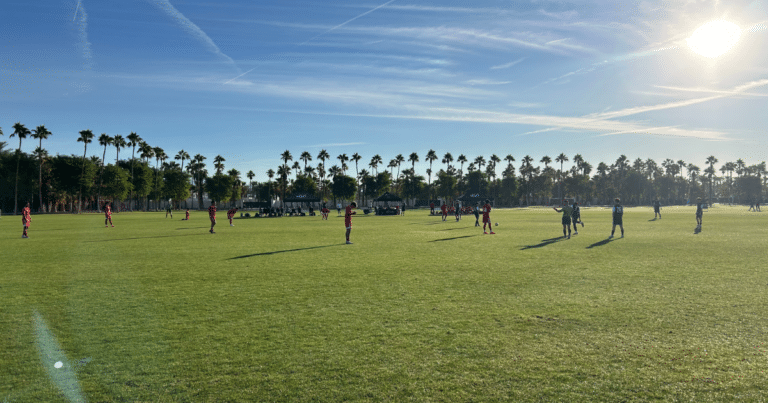World Cup 2026 Stadiums
Are you excited for the 2026 FIFA World Cup? Maybe it’s too soon to get excited. The next World Cup will be hosted across three countries for the first time ever, with the United States, Canada, and Mexico teaming up to bring the tournament to North America.
Especially here in the U.S., I think this will catapult the sport of soccer. Not only will we see the best of the best but each city will benefit from the economics of the event.
In total, there will be 16 stadiums used for the 2026 World Cup, with 11 of them located in the United States, 3 in Mexico, and 2 in Canada. The venues were chosen based on a variety of factors, including location, capacity, and overall quality.
You don’t need to be a die-hard soccer fan to enjoy the excitement of the World Cup! The event itself will be entertaining enough. But, as soccer fans, I think we are in for an amazing treat and one we will never forget about.
World Cup 2026 Overview
This will be the first time that the World Cup will be hosted by three nations, and it will also be the first time that the tournament will feature 48 teams instead of the traditional 32.
A total of 16 stadiums across the three countries have been selected to host the matches. The stadiums were chosen based on their capacity, location, and overall infrastructure. The tournament is set to kick off on June 11, 2026, and the final will be held on July 19, 2026, at the MetLife Stadium in East Rutherford, New Jersey.
The 16 stadiums selected to host the matches are some of the most iconic and impressive sports venues in North America. They range in capacity from 30,000 to 87,000 seats. The stadiums are designed to provide a world-class experience for players and fans, with state-of-the-art facilities and amenities.
United States Stadiums for the World Cup
The United States is set to host the majority of the matches for the 2026 World Cup. Here are the stadiums that have been selected to host the games:
MetLife Stadium

MetLife Stadium, located in East Rutherford, New Jersey, is the only stadium in the United States that will host two matches in the quarterfinals. The stadium is home to the New York Giants and New York Jets of the NFL and has a seating capacity of 82,500.
AT&T Stadium

AT&T Stadium, located in Arlington, Texas, is home to the Dallas Cowboys of the NFL. The stadium has a seating capacity of 80,000 and will host the semifinals of the 2026 World Cup.
Arrowhead Stadium

Arrowhead Stadium, located in Kansas City, Missouri, is home to the Kansas City Chiefs of the NFL. The stadium has a seating capacity of 76,416 and will host matches in the group stage and the round of 16.
Lumen Field

Lumen Field, located in Seattle, Washington, is home to the Seattle Seahawks of the NFL. The stadium has a seating capacity of 72,000 and will host matches in the group stage and the round of 16.
Levi’s Stadium

Levi’s Stadium, located in Santa Clara, California, is home to the San Francisco 49ers of the NFL. The stadium has a seating capacity of 68,500 and will host matches in the group stage and the round of 16.
Gillette Stadium

Gillette Stadium, located in Foxborough, Massachusetts, is home to the New England Patriots of the NFL and New England Revolution of the MLS. The stadium has a seating capacity of 65,878 and will host matches in the group stage and the round of 16.
Hard Rock Stadium

Hard Rock Stadium, located in Miami Gardens, Florida, is home to the Miami Dolphins of the NFL. The stadium has a seating capacity of 65,326 and will host matches in the group stage and the round of 16.
Mercedes-Benz Stadium

Mercedes-Benz Stadium, located in Atlanta, Georgia, is home to the Atlanta Falcons of the NFL. The stadium has a seating capacity of 71,000 and will host the semifinals and the final of the 2026 World Cup.
Lincoln Financial Field

Lincoln Financial Field, located in Philadelphia, Pennsylvania, is home to the Philadelphia Eagles of the NFL. The stadium has a seating capacity of 69,176 and will host matches in the group stage and the round of 16.
SoFi Stadium (Opted Out for the 2026 World Cup)

SoFi Stadium, located in Inglewood, California, is home to the Los Angeles Rams and Los Angeles Chargers of the NFL. The stadium has a seating capacity of 70,240 and will host matches in the group stage and the round of 16.
[Update on 10/17/2023: SoFi Stadium will not be a 2026 World Cup venue. The owner, Stan Kroenke, opted against making necessary changes from FIFA. This leaves New York’s MetLife and Dallas’ AT&T stadiums as 2026 options]
NRG Stadium

NRG Stadium, located in Houston, Texas, is home to the Houston Texans of the NFL. The stadium has a seating capacity of 72,220 and will host matches in the group stage and the round of 16.
Canada Stadiums
Canada will host two stadiums during the 2026 World Cup: BC Place Stadium in Vancouver and BMO Field in Toronto.
BC Place

BC Place is a multi-purpose stadium that is located in Vancouver, British Columbia. The stadium has a seating capacity of 54,500 and is the home of the BC Lions of the Canadian Football League and Vancouver Whitecaps FC of Major League Soccer. The stadium was originally built in 1983 and underwent a major renovation in 2011-2012 that included the installation of a retractable roof.
BC Place has hosted several major sporting events, including the opening and closing ceremonies of the 2010 Winter Olympics, the 2015 Women’s World Cup, and the 2018 Grey Cup. During the 2026 World Cup, BC Place will be one of the venues for the group stage matches.
BMO Field

BMO Field is a soccer-specific stadium that is located in Toronto, Ontario. The stadium has a seating capacity of 30,000 and is the home of Toronto FC of Major League Soccer. The stadium was originally built in 2007 and underwent a major expansion in 2015 that included the installation of a new roof and additional seating.
BMO Field has hosted several major soccer events, including the 2010 and 2016 MLS Cups, the 2014 and 2016 Canadian Championships, and the 2015 Pan American Games. During the 2026 World Cup, BMO Field will be one of the venues for the group stage matches.
Mexico Stadiums
Mexico is one of the three countries that will host the 2026 World Cup. The country will have three stadiums that will be used for the tournament. Here are some details about each stadium:
Estadio Azteca

The Estadio Azteca is one of the most iconic stadiums in the world. It is located in Mexico City and has a capacity of 87,523. The stadium has hosted two previous World Cup finals, in 1970 and 1986. It will be the only stadium in the world to have hosted three World Cup finals, as it will also host matches in the 2026 tournament. The stadium is home to Club América and the Mexico national team.
Estadio BBVA

The Estadio BBVA is located in the city of Monterrey and has a capacity of 53,500. It is the home stadium of CF Monterrey, one of the most successful clubs in Mexico. The stadium was opened in 2015 and is one of the most modern stadiums in the country. It has a retractable roof and is equipped with the latest technology to provide an excellent viewing experience for fans.
Estadio Akron

The Estadio Akron is located in the city of Guadalajara and has a capacity of 46,232. It is the home stadium of Club Deportivo Guadalajara, also known as Chivas. The stadium was opened in 2010 and has a modern design that includes a roof that covers all the seats. The stadium is equipped with the latest technology to provide a great experience for fans.
Technological Advancements
The World Cup 2026 will bring a lot of technological advancements to the stadiums and the game itself. Here are some of the new technologies that you can expect to see:
Video Assistant Referee (VAR)
Similar to the previous World Cup, Video Assistant Referee (VAR) system will be used again in the World Cup 2026 to assist the referees in making decisions.
This technology will allow the referees to review incidents on the pitch and make more accurate decisions. The VAR system has already been used in several leagues around the world, including the English Premier League and the German Bundesliga.
Goal Line Technology
Goal Line Technology (GLT) will also be used in the World Cup 2026 to determine whether the ball has crossed the goal line. This technology uses cameras to track the ball’s position and sends a signal to the referee’s watch if the ball has crossed the line.
Stadium Enhancements
The World Cup 2026 will also bring a lot of new stadium enhancements. Many of the stadiums will be equipped with state-of-the-art technology, including high-speed Wi-Fi, LED lighting, and advanced sound systems.
Some stadiums will also have retractable roofs, allowing games to be played in all weather conditions.
Sustainability Efforts
The World Cup 2026 is also committed to sustainability efforts. Many of the stadiums will be built with eco-friendly materials and will use renewable energy sources. In addition, the World Cup 2026 is working to reduce waste and promote recycling at the stadiums.
Economic Impact
Hosting the 2026 FIFA World Cup across the 16 selected stadiums in North America is expected to have a significant economic impact. According to a report by the United Bid Committee, the event could generate more than $5 billion in short-term economic activity, supporting approximately 40,000 jobs and more than $1 billion in incremental worker earnings.
The economic impact of the World Cup is expected to be particularly significant in the host cities themselves. For example, the World Cup’s impact on the economy of New Jersey, where MetLife Stadium is located, is expected to be significant. According to a report by NorthJersey.com, the event could generate up to $500 million in economic activity for the state.
In addition to the economic impact of the event itself, hosting the World Cup could also provide long-term benefits to the host cities. For example, the event could help to promote tourism and attract new businesses to the area.
I live about 45 minutes from Gillette, I could cities like Boston benefiting also from the tourism and international soccer fans flying in.
Will the 2026 World Cup Fields Be Turf or Grass?
All of the 2026 World Cup fields will need to be grass. This is because FIFA has stated that they prefer natural grass over artificial turf whenever possible. Players will echo this thought as well as it provides more give to help prevent injuries.
As of now, there are still some stadiums that have artificial turf fields. An article on The Philadelphia Inquirer reports that eight of the 16 venues chosen to host games have artificial turf fields. This has caused some concern among soccer fans, as many players and coaches prefer playing on natural grass.
Despite the preference for natural grass, some stadiums need to make changes in order to meet FIFA’s requirements. For example, an article on ESPN reports that some stadiums may need to widen their fields to meet FIFA’s regulations. Additionally, some stadiums will need to install grass over their existing turf in order to satisfy FIFA’s preference for natural grass.
Final Thoughts
As you can tell, I’m very excited that the World Cup is coming to North America. I think the soccer scene is already increasing in popularity but this will elevate it even more!
If you are lucky enough to attend a World Cup match, I just want to say that I’m super jealous. Enjoy every moment of it!

Written By: Beau Bridges
Beau is the founder of SoccerNovo, dedicated to helping players and parents navigate the youth soccer landscape. As a former youth coach and soccer parent, he shares insights on player development, recruiting, and the ever-evolving soccer scene in the U.S.
Let’s connect





